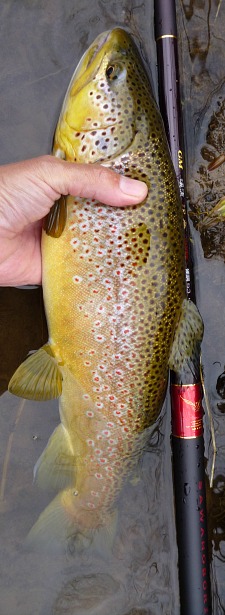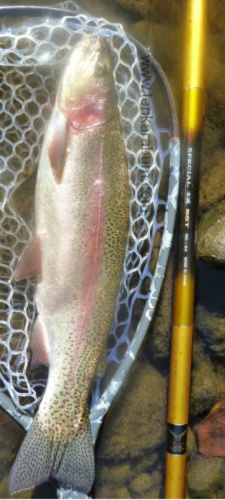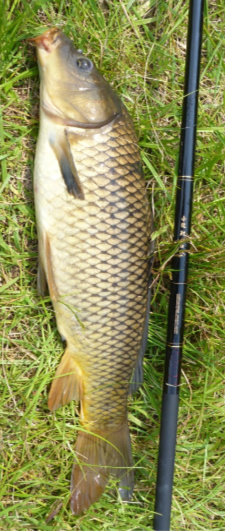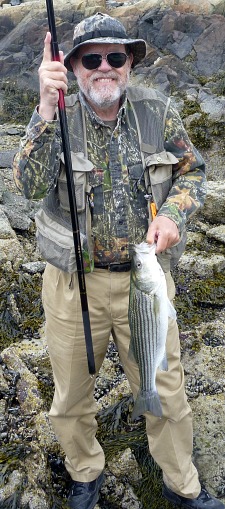Two Handed Casting
The Prologue
Most of my fishing is on small streams - small enough and overgrown enough that in spots even a 12' rod is too long. For some time, though, I have been interested in much longer rods. I got my first really long rod, a Daiwa Kiyose 53MF, a number of years ago although I must admit I haven't fished with it much. I very quickly learned two things: (1) it is too big to fish one handed, and (2) I didn't know how to make two handed casts. I could cast the rod, but I could tell that my form wasn't very good.
Not too long after I had gotten the Kiyose 53MF, I participated in a fly tying demonstration at the Catskill Fly Fishing Center and Museum. One of the guys who came and sat at my table to watch me tie and to talk a bit was Fred Krowchenko, who was one of my first customers after I started TenkaraBum. Fred and his partners, Jerry Jahn and Mary Edwards, run Spey Casting North East. We talked a bit about flies but ended up talking quite a lot about two handed casting.
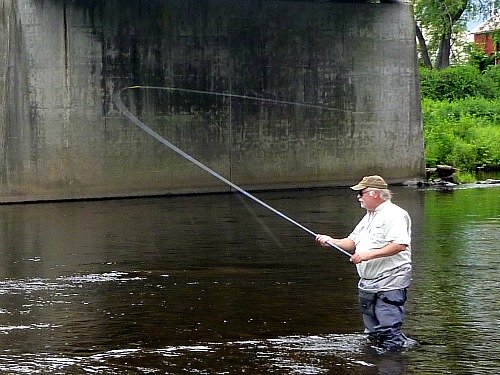 Fred Krowchenko of Spey Casting North East
Fred Krowchenko of Spey Casting North EastLike my Daiwa 53MF, most keiryu rods are intended to be two handed rods. They are long enough and heavy enough that they have to be.
Up until that day, though, I hadn't been convinced about the need to "go long." While fishing that morning, before the tying demo, I wished for the first time that I had a much longer rod. I was fishing the Beaver Kill with a Nissin 2-Way 450ZX, extended to its full 14.5' length. There were no overhead tree limbs, and there was a cobble "beach" reminiscent of the stream banks you see in the Japanese tenkara videos. Snagging trees would not have been a problem. There were bank eddies on the far shore that looked very "fishy." The water was too deep and the current was too strong to wade far enough out to reach them. One option would have been long line tenkara. Another would have been long rod keiryu.
I'm not really a fan of long line tenkara, and would rather play a fish on the rod instead of trying to hand line a good sized fish that is not ready to come in. Dr. Ishigaki and Sakakibara san occasionally fish very long lines when the stream is large and the depth and current make wading risky (the exact same conditions I faced on the Beaver Kill).
Being very realistic about it, though, when they are fishing in Japan they are catching 8-10" fish. In the US, if you fish in rivers large enough to need a long line, hooking fish of twice that size (or more!) is a real possibility. I know there are people who will say that with practice you can hand line a 20" wild trout, to which I would reply, "Yeah, but why would you want to?" To fish a longer line, I think I'll choose a longer rod.
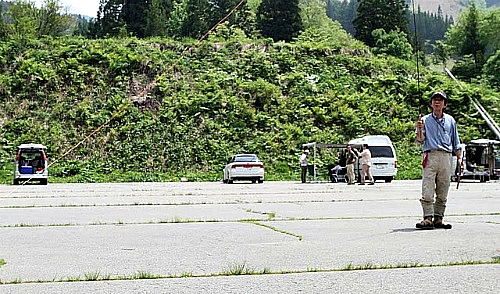 Sakakibara san casting a long line
Sakakibara san casting a long lineWhen fishing bigger water, I believe that to get the advantages tenkara provides with respect to drag free drifts and keeping your line off the water you need to lengthen your rod, not just your line. Dr. Ishigaki and Sakakibara san, at least for the times I have seen them fishing long lines, were fishing down and across and manipulating their flies. That can be a very effective approach, but if you did not want to manipulate the fly and did in fact want a drag free drift, you'll find it very hard to achieve with "long line tenkara." You might indeed want a longer rod.
To keep a longer line off the surface you need a longer rod if you are not going to purposefully impart drag (either by pulsing the fly against the resistance of the water, or swinging it and using the current pulling on the fly to keep the line tight).
A rod longer than the 450ZX - at least one capable of handling the fish you might catch in larger rivers - would have to be a two handed rod. Holding a rod with both hands greatly reduces the feeling of tip heaviness and thus allows you to fish a much longer rod.
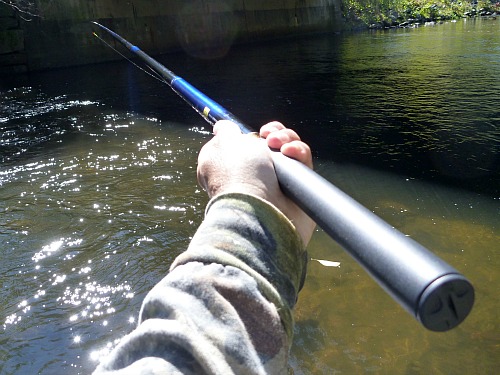 The Daiwa Kiyose 53MF is too big for one handed casting
The Daiwa Kiyose 53MF is too big for one handed castingAfter feeling the
need for a longer rod and speaking to Fred about two handed casting, I
wanted to see what Spey casting techniques might be applicable to tenkara fishing. I ordered some longer rods and booked a
class with Fred and Jerry at Spey Casting North East.
The Lines
Before going, I had anticipated that the Rio Power
Flex Core .024" running line would be a good choice. That's the line I
used when reviewing the TFO Soft Hackle tenkara rod. I thought then that
the line was quite heavy, but the Soft Hackle is a stiff rod and needs a
heavy line. I figured that the longer rods might need a heavier line and that a heavier line might be needed to load the rod with the Spey cast's famous "D" loop. Also, since it is a floating line, I thought the water "anchor" of the Spey cast would work better with it.
What I knew but what hadn't really registered beforehand was that the Rio line is not very dense - it is after all a floating line. Due to the lack of density, the line lost all its momentum to wind resistance and despite being a heavy line, I couldn't cast it very far. And it wasn't just me. Neither Fred nor Jerry were at all impressed with it as a line for tenkara/keiryu two-handed casting.
Even
my mainstay - fluorocarbon level line - in this case some of my remaining
supply of size 5 Sunline, failed to satisfy the Spey casting
instructors. What did impress them, though, were a couple of the furled
fluorocarbon lines made by John Vetterli of the Tenkara Guides in Salt
Lake City, UT. John's lines are heavier and they are also tapered, both of which contributed to their performance advantage over the other lines. [The Nissin PALS SP Pro twisted fluorocarbon lines are quite similar and would have worked nicely.]
Fred also seemed pretty impressed with how well a horsehair line casts. I only had a fairly light one with me, and he cast it with a lighter rod, but it would not be hard at all to make a horsehair line that would cast like a bullet with a two handed rod.
Once we got the lines sorted out, Fred and Jerry went through their repertoire of Spey casts with John's 20' and 28' lines and the rods I had brought, the Daiwa Kiyose 43MF and 53MF, and the Nissin 2Way 540ZX and 620ZX (both rods were the medium stiffness).
The Casts
Before going to the class, I didn't really understand Spey casts - and to be frank, I'm sure I still don't. I had thought that they were basically roll casts, using a combination of the weight of the line in the "D" loop and the resistance of the line in the water to load the rod enough to make the cast. It seems I overestimated the importance of the water and underestimated the importance of the weight of the line.
A tenkara line just does not have sufficient mass to load the rod with the classic Spey casts: the Single Spey, Double Spey, Snake Roll or Snap-T casts. A cast called the Perry Poke worked pretty well. Quoting Fred, "(for RH caster) drag and drop the fly off your RH shoulder then very slowly drop the rod tip towards the water, continuous motion sweep to the rear with upward circle up to forward cast. Very nice for conditions up against cover or trees on your back."
I think the "continuous motion sweep" may be the key, because the cast that worked the best was the CM/CL (continuous motion / continuous load) cast, also called a Belgian cast. I remember Misako Ishimura speaking of the Belgian cast for tenkara. In addition to being the co-author of Tenkara Radically Simple, Ultralight Fly Fishing Misako is also an FFF certified fly casting instructor. Unlike the traditional fly cast or tenkara cast with its back cast, pause, forward cast, the Belgian cast keeps the rod loaded the entire time as the rod almost circles around without stopping until the forward cast is completed.
I suspect that the cast that David Webster wrote about in his 1885 book "The Angler and the Loop Rod" must have been quite similar to a Belgian cast, seeing as how he described the cast as causing the tip of the rod to "describe something of a horse-shoe curve." Webster went on to write "the point of the rod should not be carried much behind the body, and the line should not be sent out to its full length behind, but brought round in a curve, following the motion of the rod until fairly on the forward movement, when a slightly quickened action is imparted..."
Webster fished a 13.5' wooden rod and a line, tied to the rod tip, that measured 39' from rod tip to the last of his nine flies. (You can imagine the tangles you could get from fishing nine flies at once.) The horseshoe curve Webster described is almost exactly how you would describe the path the rod tip takes when making a Belgian cast.
In my session with the Spey Casting North East instructors, the Belgian cast was almost a necessity when casting a heavy Czech nymph. With an unweighted soft hackle (and many of the flies Fred and Jerry fish are soft hackles), a more standard back cast, pause, forward cast also works (and is a much easier transition for someone completely new to two handed casting).
This is Going to Take Some Practice
Needless to say, I did not master two handed casting in one session. I have to say I didn't master it in my second session, either. The second session, on my own and thus with no guidance or feedback from an expert, was limited to unweighted flies and to a more standard back cast, pause, forward cast. Probably because of the more familiar motions, more of my casts extended fully and a much greater number put the fly very close to where I wanted it. Still, I can cast much better one handed than I can two handed, or rather, I can still cast much better one handed.
Fred and Jerry both marveled at the Daiwa Kiyose 43MF for it's light weight and sensitivity (not to mention low cost compared to a full Spey outfit). It's light enough to cast one handed, though, even at full extension, and that's how I've always cast it.
The longest tenkara rods are also about that length. The Daiwa Enshou LT44SF, the Nissin Air Stage Honryu 450 and the Shimano Mainstream 40-45 ZE similarly are all one handed rods intended for mainstream (river) fishing. Beyond that length, though you're entering two handed territory.
For big water and big fish, I really believe you're going to need big rods. It's not tenkara as practiced in Japan, so it hasn't been part of the dialog for the last few years. It's not really keiryu fishing as practiced in Japan either, so there may not be any masters to rely on. I think we may have to make our own way on this one.
Update
Over a year has passed since this essay was first written. I've done a bit more two handed casting with the Daiwa 53MF, Nissin 2-Way 540ZX, and the really very nice Suntech ZPRO 54 and Kaname 63.
In the intervening year, I have come to a striking conclusion. The casting I did with Fred and Jerry is not the way I want to fish, not at all. During our session together, we focused on long lines, with the line itself about 1.5 times the length of the rod and then 4-5' of tippet.
Through practice, I gradually came to the conclusion that shorter lines were much, much better. Japanese keiryu anglers do not fish long lines. Rather than trying to copy long line tenkara with a keiryu rod, I started trying keiryu practices with a keiryu rod (seems obvious after the fact).
With a line plus tippet the rod length or shorter, I could cast very light lines very effectively. I was actually a little shocked to discover how easily the 53MF cast a short size 3 line when neither I nor the instructors could cast a long size 5 line effectively.
However, and I need to emphasize this, it's not about the casting. It's about the fishing. Long lines are subject to drag. The laws of physics cannot be broken. You just can't keep a long line off the water unless you are dragging your fly to do it. Less drag means better presentations, and better presentations yield more fish. I now fish with a line plus tippet shorter than the rod - a couple feet shorter than the rod.
My two handed casting now is not spey casting at all. It is much closer to a sidearm tenkara cast, but ending with the rod tip high, just as with a standard overhead tenkara cast. That is what gives you the fly hitting the water before the line - and if your line is enough shorter than the rod, the line never hits the water at all - just the fly and tippet. Your rod is ready to set the hook the instant the fly hits the water. When I have fished the keiryu rods with bait, as is generally done in Japan, it was surprising how often the hit would come almost instantaneously.
I am a much bigger fan of long rods and two handed casting now than I have ever been. For any stream without overhead tree limbs, longer rods will indeed give you better presentations. You can cast rods up to about 4.5m effectively one handed. From the Nissin 2-Way 450ZX (stiff) and all longer rods, though, two handed is the way to go.
Second Update
I would guess about another year has passed and in the past year I have had some surprisingly good days fishing with two handed rods. I now believe that any river over about 30' wide can be fished much better with a long rod - long enough that you will have to fish it with both hands.
There are "honryu" tenkara rods intended for larger streams. Most are 4.5 meters (about 14.5') and can cast a long line. You can certainly cover a lot of water with them, but your drifts will be better with a longer rod and shorter line. A 17.5 foot rod and 14.5 foot line will give you better drifts than a 14.5 foot rod and 17.5 foot line. That is particularly true if you are fishing weighted flies. Less of your line will be in the water subject to current differentials.
For that matter, a 20.5 foot rod and 17.5 foot line will be even better.
If you are fishing a river that is wide enough that there are no overhead tree branches I would strongly urge you to fish a longer rod, a two handed rod. I really do think you will catch more fish.
I started this essay saying that most of my fishing is on streams small enough and overgrown enough that in spots a 12' rod is too long. Over the last couple years, I have become so impressed with the effectiveness of two handed rods that much of my fishing is now on larger streams - large enough that I can use my two handed rods.
Think of the advantage your 12' tenkara rod gave you over your 8 or 9' fly rod. Truly, you will get that same advantage AGAIN by fishing with a much longer, two handed rod. Plus, and this may surprise a lot of people, when fished and cast with both hands, the longer rod puts much less strain on the wrist and shoulder than a 12' or 13', and certainly a 14.5' one handed tenkara rod.
Give it a try, it will open up a whole new world of fixed line fishing.
Third Update
Beyond opening the door to fishing bigger water, two handed casting opens the door to fishing for bigger fish. The old Burger King commercial had it right: "It takes two hands to handle a whopper."
When fighting a big fish, the leverage is such that you will need two hands to hold the rod. Additionally, a longer rod is much more capable of guideing a fish (by holding the rod to the side rather than straight up) than is a shorter rod. As Tenkara Guide Erik Ostrander taught me the first time I tried carp fishing with a keiryu rod "You can't stop it, but you can turn it."
I recently received an email from a customer who fishes a heavily pressured stream. He was lamenting that in the upper stretches, where the stream was still pretty small, he could reach the bank eddies on the far side, which the fly fishermen couldn't fish because of the inescapable (for them) drag, but lower down where the stream got wider, he couldn't reach them with the longest rod he could fish one handed.
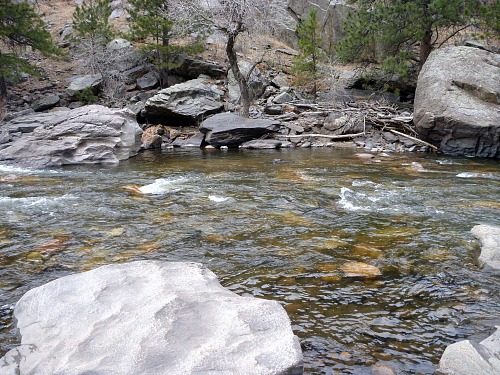 Different river, same scenario.
Different river, same scenario.To me, the solution was obvious - get a longer rod and fish it two handed. Been there, done that. If you want to reach over the entire river and fish the bank eddies on the far side you need a two handed rod.
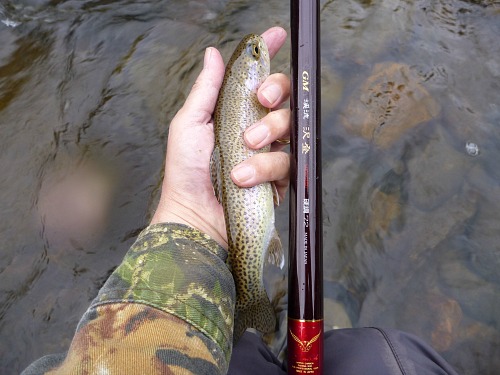 This fish was in that eddy!
This fish was in that eddy!If the fisherman's trail is along one side of the stream, or even worse, if there is a road along the stream, I can almost guarantee you that most of the fish will be along the other side.
TenkaraBum Home > Two Handed Casting
“The bitterness of poor quality remains long after the sweetness of low price is forgotten” - Benjamin Franklin
"Be sure in casting, that your fly fall first into the water, for if the line fall first, it scares or frightens the fish..." -
Col. Robert Venables 1662
As age slows my pace, I will become more like the heron.
Warning:
The hooks are sharp.
The coffee's hot.
The fish are slippery when wet.
Beware of the Dogma
Currently processing orders that were received Mar 8.
This Just In
I have been Western fly fishing for over 45 years and spey fishing the past 8 years because joint problems. 2 handed rods for me is the norm, and since discovering Keiryu it has definitely opened up new possibilities with the incredible drag free natural drifts possible especially for trout
Vince C, British Columbia



